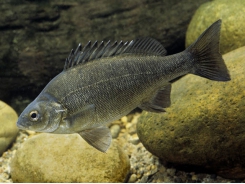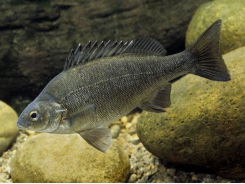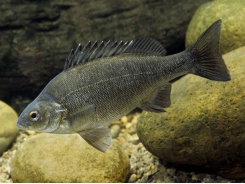Diseases of the Australian Freshwater Fish Silver Perch (Bidyanus bidyanus) - Part 8

NOXIOUS ALGAE
Noxious phytoplankton has been implicated in fish kills worldwide with the majority of problems occurring in marine systems. Noxious algae have not caused serious losses on silver perch farms, but some unexplained fish mortalities have been associated with algal blooms. In one instance, large silver perch suffered 100% mortality following the ‘crash’ of a large algal bloom containing the bluegreen algae Microcystis flosaquae and Anabaena circinalis; both species are known to be potentially toxic (Fig. 96). The crash was preceded by extreme pond water temperatures (>30°C) followed by heavy rain. Fish displayed erratic behaviour, schooling at inflowing water and those fish that were harvested recovered in tanks within 36–48 hours. Other water quality variables, except the very high temperatures were at acceptable levels throughout the event. It is possible that the algae released toxins after death and decay. However, the evidence linking fish morbidity/mortality and algal toxins under aquaculture conditions remains limited.
Signs
Fish swimming around pond edges
Erratic swimming (jumping, jerky movements, swimming in circles)
Acute mortality
Skin and fin redness
Diagnosis
Definitive diagnosis can only be done at a toxicology laboratory; fish need to be transported frozen and a water sample (2 litres) should be collected for algae identification (examination within 24 hrs or following preservation in Lugol’s iodine solution and refrigeration); elimination of another aetiology (parasites, bacterial, viral and water quality) necessary to support diagnosis of algae toxicosis.
Treatment
Provide water exchange and 24 h aeration immediately; undertake emergency harvest when losses are thought to be imminent.
Prevention
Algacides can reduce noxious algae in ponds, but care must be taken to avoid oxygen depletion; maintain good water quality; reduce feeding during high water temperatures and heavy blooms of bluegreen algae (Fig. 97); dry and clean ponds on a regular basis (every 2 to 3 years).

'CLOUDY' EYES AND RED TAILS
Cloudy eyes and haemorrhaging of the fins (and skin) are usually the result of poor husbandry techniques (Figs. 98 and 99). The problem often manifests in silver perch in tankbased quarantine and purging systems following harvesting or confinement in transport containers. The problem is more prevalent at warmer water temperatures (>20°C) and when fish are confined in waters having high organic load. The aetiology of the disease is unknown; the cause is most likely a combination of abrasive, rough handling, crowding in nets and harvest bins, and poor water quality (low DO; high solids, movement of fish between waters having significant differences in pH) associated with excessive stocking densities and stress. Transporting fish, even for short periods, in small vessels such as buckets or bins and the over loading of fish in hand nets has caused eye damage. The problem is exacerbated when using coarse netting or makeshift nets using plastics or other similar materials.

Silver perch will recover in 3–5 days if held in sanitary conditions (clean water; high DO), using salt and at normal stocking densities.
Signs
Opaqueness of one or both eyes
Haemorrhaging of fins particularly caudal fin
Scale loss
Redness of skin, particularly below the lateral line
Diagnosis
Presumptive diagnosis is based on observation of the clinical signs during or soon after handling procedures.
Treatment
Tanks:
mild clinical signs: hold fish at stocking densities <30 kg/m3 ; provide salt (NaCl) at 2 g/L indefinitely; flush and retreat salt every 24 hrs for first 2–3 days; maintain clean water and high aeration (DO >4 mg/L). More severe cases: as above with daily salt baths at 10 g/L for 1 hour; secondary bacterial infections may require antibiotic treatment but generally improvement in water quality, good husbandry and hygiene will help lesions resolve spontaneously.
Prevention
Avoid harvesting in poor water quality and at high temperatures (>28°C); use anaesthetic prior to hand netting fish; provide bottled oxygen through a high quality ceramic airstone during postharvest transportation from ponds; avoid overcrowding in harvest bags and transporters; avoid handling fish compromised by disease or nutritional disorders unless emergency harvest indicated; use knotless nets.
PHYSICAL ABNORMALITIES
The incidence of abnormalities has increased in the silver perch industry over the last 5 years, with the most common being curvature of the spine (scoliosis and lordosis), deformed heads called ‘axeheads’ or ‘snubnosed’, deformities of the opercula bones, reduced or missing pelvic fins, and ‘paintbrush’ caudal fins (Figs. 100, 101, 102, 103, 104 and 105). Jaw deformities have also been reported on some farms.


The causes of the abnormalities are uncertain, but most are probably a result of inappropriate hatchery practices including inbreeding and the use of poor husbandry during egg incubation, hatching and larvae rearing stages. During the hatchery phase, broodfish, eggs and larvae should be handled with great care to minimise physical damage, and maintain the highest quality water and optimum nutrition; water should be well filtered and oxygenated, and be free of pathogens and any heavy metals. Eggs and larvae should not be overstocked and any artificial diets used for postlarvae and juveniles should contain the appropriate ingredients, particularly vitamins and minerals.
Signs
Spinal curvature
Deformed or missing opercula
Deformed fins
Jaw and head anomalies
Diagnosis
Many possible causes for developmental anomalies; determining genetic link often accomplished by ruling out other possible causes.
Prevention
Use recommended hatchery and larval rearing techniques; follow recommended breeding programs; do not use broodfish suspected of being closely related or with unknown origin (e.g. caught in farm dams); replace broodfish suspected of carrying deleterious genes; use genetic strains known to be suitable for intensive culture; tag all broodfish and keep records of fish performance (weight, breeding performance, matings, etc); use high quality artificial feeds. Cull all abnormal fry prior to stocking.
ABDOMINAL SWELLING (‘bloat’)
There have been several reports of silver perch affected with gases in the abdominal cavity. Fish with this syndrome have a greatly distended abdomen, float inverted on the pond surface and are unable to feed or function normally; most eventually die.
The prevalence of the disease within the pond, in the fewrecorded outbreaks has been relatively low (<1% fish affected) and the cause remains unknown. Possible causes may include systemic bacterial infection, ingestion of contaminated feeds or ingestion of noxious algae.
Some episodes have followed the recommencement of feeding after feeding was terminated for 1–3 days due to water quality issues or feed availability. Abdominal distension has been recorded in other species caused by swim bladder malformation and/or dysfunction; fish exhibiting abdominal swelling should be dissected to determine the site of the problem (organs or body cavity) and if the swelling is caused by fluids or gas.
Signs
Distended abdomen ( Fig. 106)
Organs or body cavity inflated with gases or fluids
Fish inverted at pond surface, inability to swim normally

Diagnosis
Observation of typical abdominal distension and abnormal behaviour.
Treatment
Unknown.
Prevention
Aetiology unknown; ensure feed is fresh, mouldfree and correctly stored (cool, low humidity); maintain good water quality with aeration.
Related news
Tools

Phối trộn thức ăn chăn nuôi

Pha dung dịch thủy canh

Định mức cho tôm ăn

Phối trộn phân bón NPK

Xác định tỷ lệ tôm sống

Chuyển đổi đơn vị phân bón

Xác định công suất sục khí

Chuyển đổi đơn vị tôm

Tính diện tích nhà kính

Tính thể tích ao









 Diseases of the Australian Freshwater…
Diseases of the Australian Freshwater…  Diseases of the Australian Freshwater…
Diseases of the Australian Freshwater…